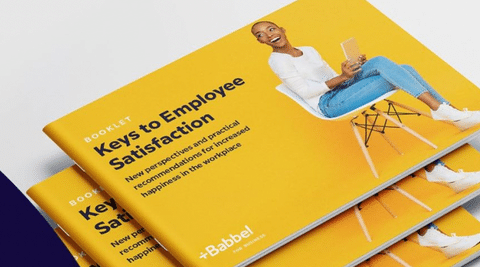In this post, we explain what the Great Reshuffle is and what’s driving it. We also consider what the Great Reshuffle means from an employer’s perspective and share 5 key strategies for staying competitive.
You’ve heard of the Great Resignation — the pandemic-driven trend that saw record numbers of people quit their jobs.
But people didn’t just quit the workforce and never return. They’re now seeking opportunities that better align with their needs and values. This is the next big shift in the labor market: the Great Reshuffle.
So what exactly is the reality behind the buzzword? What’s driving the Great Reshuffle and what does it mean for employers?
Keep reading to learn everything you need to know about the Great Reshuffle, including how to navigate it successfully.
Table of Contents
- What is the Great Reshuffle?
- What’s driving the Great Reshuffle?
- What does the Great Reshuffle mean for your company?
- How to navigate (and thrive in) the Great Reshuffle: 5 key strategies
- The takeaway

What are the keys to employee satisfaction?
Discover helpful tips to achieve employee happiness in our practical booklet “The Path to Employee Satisfaction.” Download it now for free!
What is the Great Reshuffle?
In 2021 and beyond, people were voluntarily quitting their jobs in record numbers — a labor market trend coined by Professor Anthony Klotz as the Great Resignation.
This seemed to be triggered by the global pandemic, with people reflecting on their values, experiencing more flexible ways of working, getting a taste of a healthier work-life balance, and ultimately deciding to quit jobs that didn’t make them happy.
Some people quit their jobs and didn’t return to the workforce, including many older workers who retired earlier than planned. Others (53%) went on to change their occupation or field of work.
For many, the Great Resignation wasn’t about quitting work altogether. It was about rethinking their career goals and seeking opportunities that better align with their needs and values.
This large-scale career recalibration is known as the Great Reshuffle. It’s the next chapter after the Great Resignation, and it’s in full swing. In a 2023 survey of 7,000 workers, 75% of respondents said they are planning to look for a new job in the next 12 months — up from 65% in 2022.
But why? Let’s take a look in the next section.

What’s driving the Great Reshuffle?
The main driving force behind the Great Reshuffle is a big shift in people’s expectations and values. Employees’ priorities have changed; they want different things compared to, say, four years ago — and they’re more empowered to go after them.
So what do people want from their careers that they weren’t getting before?
According to Pew Research Center, the top five reasons people gave for quitting their jobs amidst the Great Resignation were:
- Low pay
- Lack of opportunities for advancement
- Feeling disrespected at work
- Childcare issues
- Not enough flexibility to choose when to put in hours
It makes sense, then, that people are forging new career paths and choosing their future employers based on a desire for:
- More flexibility and remote work
- Better pay
- A healthier work-life balance
- More opportunities to learn and grow
- More meaningful, impactful work that aligns with their values
For some, this has meant pursuing a freelance career or starting their own business. As a result, the number of self-employed workers in the US has risen by 500,000 since the pandemic.
For others, this means retraining to make a complete career change and/or switching companies, favoring employers who offer a more desirable package.
And it seems to be paying off. Of those who quit during the Great Resignation and found employment elsewhere, 56% are earning more money, 53% have more opportunities for career advancement, 53% find it easier to balance work and family responsibilities, and 50% enjoy more flexibility (Pew Research Center).
In episode 13 of our podcast, we talk about how workations are popular employee benefits that can help your employees feel less stressed and create a healthy work-life balance. Listen here:
What does the Great Reshuffle mean for your company?
Both the Great Resignation and the Great Reshuffle have created a more competitive hiring landscape. This has been termed the war for talent, emphasizing how employers must now work harder to attract and retain skilled workers.
Amidst the Great Reshuffle, people are rethinking their priorities, values, and career goals and seeking opportunities that align with their needs. Employers who aren’t equipped to provide such opportunities may notice:
- Higher than usual turnover as skilled employees find opportunities elsewhere
- Increased difficulty in attracting and hiring new talent
- A drop in employee engagement and company-wide morale (which may lead to increased rates of quiet quitting)
This might include updating your employee benefits package, rethinking your stance on remote and hybrid work, or increasing your investment in training and internal mobility — anything that improves the employee experience and positions your company as an appealing place to work.
With that, let’s outline some concrete steps you can take to successfully navigate the Great Reshuffle in the next section.
You can learn more about the benefits of Babbel as a corporate benefit here.

How to navigate (and thrive in) the Great Reshuffle: 5 key strategies
Staying competitive in the Great Reshuffle is a case of setting yourself apart as a desirable employer. Here are five strategies that will help you:
- Ask, listen, and adapt
- Double down on employee retention
- Invest in training, upskilling, and career growth
- Prioritize work-life balance
- Offer fair and competitive compensation
Let’s explore how you can put these into action.
1. Ask, listen, and adapt
The Great Reshuffle is the result of a significant shift in employee needs, goals, and values. As a first step, seek to understand how this broader shift relates to your own employees.
Take stock of where you currently stand when it comes to employee satisfaction and identify areas for improvement. Ask your employees directly, listen to their feedback, and commit to making the necessary changes.
2. Double down on employee retention
The best thing you can do to weather the Great Reshuffle is to focus on employee retention.
Keep employee turnover low and you’ll not only save money — you’ll also boost morale, improve company culture, and benefit from a highly skilled workforce who knows your product or service inside out.
So where to begin?
Among the most important factors for employee retention are:
- Competent and supportive managers and leaders
- Regular feedback and employee recognition
- Fair compensation
- Opportunities for growth
- A healthy work-life balance
In addition to our first strategy (asking your employees for direct feedback), be proactive in reviewing your employee retention efforts.
If the answer isn’t a resounding yes, it’s time to double down on your employee retention strategy.
3. Invest in training, upskilling, and career growth
The benefits of this strategy are twofold. Firstly, investing in your employees’ career growth will help to improve retention. Secondly, you’ll find it easier to address emerging skills gaps and fill new roles internally. Everyone’s a winner!
The goal is to create a learning culture; one where every employee feels empowered to learn new skills, has access to a variety of learning resources, and has the opportunity to advance and progress.
Here’s how you can achieve this:
- Work with employees one-on-one to set goals and devise personalized career pathways.
- Leverage key learning and development trends such as microlearning, personalization, and collaborative learning to provide a rich and varied learning experience.
- Foster internal mobility by putting employees forward for new roles and promotions, and enable career changes within the company.
Lack of opportunities for advancement is one of the top reasons people quit, so prioritizing employee learning and development is key.
You can learn more in this guide: The Importance of Talent Development (and How to Master It).
4. Prioritize work-life balance
In a 2023 survey carried out by The Muse, work-life balance ranked as the most important factor in finding a new job across every generation apart from Baby Boomers.
Notably, 60% of Gen Z respondents prioritize work-life balance, compared to just 40% who prioritize compensation.
If you want to hold on to your employees and have a chance at attracting new hires, prioritizing employee work-life balance is a must. This includes offering more flexibility and enforcing stronger boundaries between work time and downtime.
We’ve outlined the best strategies for fostering a healthy work-life balance (and why it matters) in this guide.
5. Offer fair and competitive compensation
Salary may not be the top priority for employees, but it’s a very close second. In the aforementioned survey carried out by The Muse, only 3% more respondents overall said that work-life balance was more important than compensation.
So what exactly constitutes fair and competitive compensation, and how can you make sure you’re offering it?
- Conduct thorough and regular market research to set competitive salary benchmarks and establish salary bands for each role within the company.
- Be transparent; clearly communicate which factors and metrics determine an employee’s salary.
- Strive for pay equity; identify and close pay gaps, paying close attention to underrepresented groups and employees with protected characteristics. You can learn more about achieving pay equity in this guide.
Don’t make the mistake of believing that flexible work can replace fair compensation. It’s not a one-or-the-other scenario; competitive employers offer both.
The takeaway
On the surface, trends like the Great Resignation and the Great Reshuffle might seem like bad news for employers. In reality, they’re only bad news for employers who aren’t willing or able to evolve in line with the rest of the job market.
For great employers, the Great Reshuffle is an opportunity to improve, advance, and stand out. It’s your chance to set yourself apart as an excellent place to work, and to build a team of the most talented, engaged, and happy workers.
If you’d like to learn more about staying competitive, check out these five strategies to grow and future-proof your business or learn how to develop a winning employer brand in this guide.

What are the keys to employee satisfaction?
Discover helpful tips to achieve employee happiness in our practical booklet “The Path to Employee Satisfaction.” Download it now for free!





